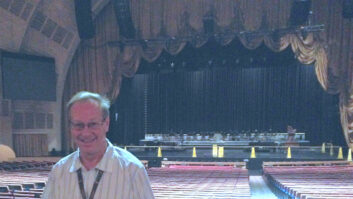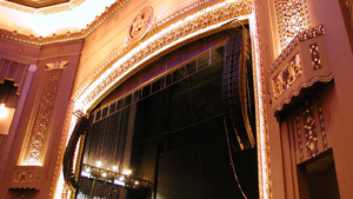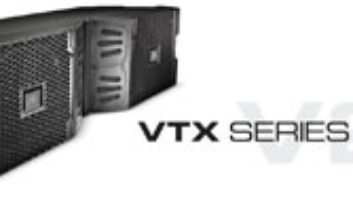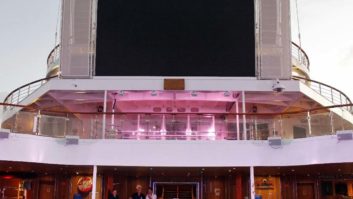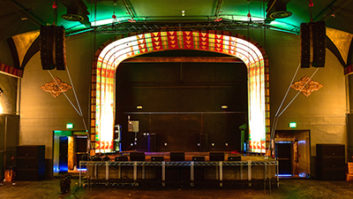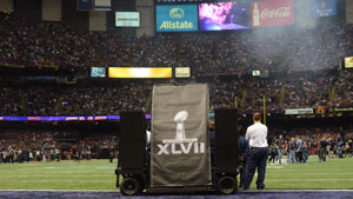Introducing a new P.A. system always involves an element of risk. Yet, to introduce its new VERTEC line array speaker system, JBL Professional picked one of the highest-profile events of the year – the Democratic National Convention (DNC), held during the week of August 14th in the Staples Center, Los Angeles.
Event sound designer for the DNC was Patrick Baltzell, who designed a distributed sound system made up of numerous satellite arrays, an effective method for coping with the cavernous venue’s acoustics. In all, Baltzell used 68 of the new VERTEC Series VT-4889 enclosures.
Fourteen of the VERTEC line arrays were hung from the ceiling. Three six-box arrays were flown more than 50 feet above each side of the oversized rostrum, covering the main floor and forward seating rows. Another eight four-box arrays, distributed in an arc farther back, were aimed to cover back and side seating areas of the arena. Immediately noticeable to anyone who has seen other line array systems deployed was the rather extreme angles at which the VERTEC arrays could be flown, due to a unique, rigid rigging system.
Sound services for the event were provided by Audiotek Corp. (Burbank, Calif.), whose chief engineer, Scott Harmala, supervised the temporary installation. ATK (a 2000 TEC Award nominee) specializes in sound reinforcement for televised events, especially those which include live music. The company is no stranger to line arrays, having previously purchased systems from two different manufacturers.
ATK was assisted at Staples Center by members of I.A.T.S.E. Local #33, which includes a number of veteran, audio-savvy individuals like David Velte, who had praise for the VERTEC system’s design. “Whatever JBL has done to make the boxes this lightweight, I guarantee stagehands don’t mind a bit!” noted Velte.
SYSTEM DETAILS
The VERTEC system incorporates the latest in component and materials technology. Each box is made of a composite material similar to that used in JBL’s HLA subwoofer, and each VERTEC enclosure weighs only 152 pounds. The box measures about 20 inches tall and deep and only about 47 inches wide. These dimensions allow boxes to be stacked on end, two high, even in the smaller, non-trailer trucks used by many concert sound companies. In fact, 100 of the boxes can be stacked in a 24-foot truck body.
The enclosure’s back panel is slightly shorter than the front dimension, allowing up to 10 degrees of vertical splay angle between one speaker in an array and the next, while keeping the front edges of the enclosures coupled tightly together.
A tubular frame on either side of the enclosure has integral, captive rigging hinges that slide out and couple one enclosure to the next with single-degree resolution. This reportedly saves both time and cost, as additional “loose” rigging parts are not required. The manufacturer advises that up to 18 of the VT-4889 enclosures can be suspended from the 4889-AF (Array Frame), made of high-grade, lightweight aluminum, with a 7:1 safety factor.
The box geometry has a number of advantages when multiple units are arrayed, as a greater vertical coverage angle can be achieved with fewer boxes. In many situations, such a design would only be of real benefit if each enclosure had very high-output characteristics – and that’s where JBL’s leadership position in loudspeaker transducer design comes in.
WHAT’S INSIDE THE BOX?
The VERTEC system incorporates JBL’s latest generation of components, all with neodymium magnet structures. The cones are all JBL’s advanced Differential Drive (dual-coil) loudspeakers. A 15-inch woofer is positioned at either end of the enclosure, next to the low-frequency ports. In the center of the box is a thin “ribbon” of three WaveFormers, each fitted with JBL’s new 1.5-inch exit compression drivers with 3-inch diaphragms. These specialized devices are lined up vertically for the entire height of the enclosure.
At each side of the WaveFormer exits are two pairs of high-powered, 8-inch midrange speakers. These are mounted at 90 degrees to each other behind the unique exit flares, dubbed the Radiation Boundary Integrator[TM], or RBI (patent pending). The precisely angled RBI extends the high-frequency section out to the radiating boundary of the 15-inch speakers and has pairs of slots for each of the midrange drivers mounted behind it.
VERTICAL TECHNOLOGY
The VERTEC system is reportedly the first product to result from a long-range R&D program to explore the theoretical mathematical and physical concepts shaping the acoustical performance of line arrays. “Once the Line Array Directivity Equation was empirically derived, it became apparent to our development team that traditional midrange and high-frequency devices could not be used to achieve true precision coverage characteristics in arrays of this type,” explains David Scheirman, director of tour sound for JBL Professional. “Innovative, new acoustical elements were designed and prototyped. Comparative measurements and listening sessions showed that the ultimate performance of line array systems in listening spaces can be well-correlated to the foundation theories first presented by acoustical pioneers like Harry Olson.”
JBL first developed and sold line array systems in 1975. “In some ways, you could say this `year 2000′ version, while larger in scale and capable of much higher output levels, is still based on the fundamental acoustical principles that have been with our industry for some time,” Scheirman notes. “The recent market trend toward large-scale, high-powered line arrays makes this an appropriate time to provide VERTEC to meet the demands of professional users.”
To assist system users, JBL has developed proprietary software (the VERTEC Line Array Calculator) that allows the pre-event design and prediction of an array’s performance before it is actually set up in a venue. Keyed to the physical dimensions of the VT-4889, this handy application not only allows users to design systems to match each seating plane, it shows anticipated sound-pressure levels at 11/43-octave frequencies at any distance from the array. Taken together, the Line Array Directivity Equation, the innovative patent-pending acoustic elements developed for the VERTEC VT-4889 enclosure and the predictive software package represent the first market application of JBL’s Vertical Technology.
